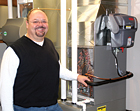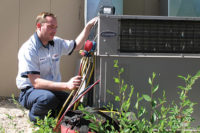
Routine maintenance and service agreements keep service techs like this one from Isaac Heating & Air Conditioning busy despite economic conditions.
The heating and cooling trade was not immune to the woes of the recent economic recession. While millions of Americans lost their jobs or homes or both, the HVAC trade was learning to deal with the reality of possible loss of profits from falling revenues, a shift in the market from replacement to repair, and an influx of new business owners bent on lowering prices and lowering credibility of the trade.
On the surface it would seem like a no-win scenario for HVAC contractors. The years leading up to 2009 - for some - were healthy and full of growth. Or at least, business was good and there were no dark clouds on the horizon. Others may have been teetering on the edge between marginal profitability and red ink. These were the businesses that were most susceptible to failure or, at a minimum, to significant downsizing.
Several contractors agreed to talk about their business experiences before, during, and after the recession. Their stories are ones of encouragement and forward thinking, giving hope to others who did not see a recession as an opportunity as they did - but as an unwelcome speed bump in their business model.
“The time before the recession was a period of growth for us,” said Mike Salmon of Anderson Air Corps (Albuquerque, N.M.). “We doubled our business in three years and we looked forward to the future with optimism. We were positioned well with consistent advertising, strong affiliations, and a growing customer base. We set ambitious goals and saw no reason why they could not be achieved.”
Salmon is one of several HVAC contractors who had built strong business foundations but who also were realistic about the impending economic downturn. “Service and AOR [add-on and replacement] were growing at a reasonable pace so there were no warning flags going up there,” he said. “But commercial new construction was spooky. It was becoming too easy to get jobs - and good profit jobs at that. The closing rates were unnaturally high. My sixth sense went off sometime in 2006 and I recall the distinct feeling that this enhanced market environment couldn’t last.”

Tom
Stritecky of Waterbury Heating & Cooling Inc., Sioux Falls, S.D., ramped up
his business during the recession.
WHEN THE GOING WAS GOOD
The years leading up the recession were not necessarily atypical. It was commonplace to see contractors adding to their business mix, exploring new trends in the market, and finding new ways to build a strong customer base. Tammy Denton of DHC Comfort Inc. (White House, Tenn.) saw good enough growth to add staff and look for a larger facility. “It was 2009 and we were excited about all the growth,” she said. “2007 was probably our best year and we were gearing up to continue the growth. We added another salesman and had about 14 people on staff at the time. We purchased a building and property in mid-2008.“Our business was growing by being involved in local community activities and doing a little marketing to our existing customers. Most of our customers came from referrals or our contractors. We worked with remodeling contractors and did small commercial projects, HVAC for home additions, and some custom homes. We were doing a lot of employee training for our techs.
“It was in the third quarter of 2008 when we started to notice a slowdown in our sales.”
Denton knew she had her work cut out for her. “The first quarter is always the toughest for us in our area, and it is crucial to make the numbers come in,” she said. “I knew after seeing 2008 numbers, hearing the news reports, and witnessing all the layoffs around the country, that we were going to have to do something drastic if we were going to make it through this recession.”
Frank Detmer of Detmer & Sons (Fairborn, Ohio) was leading his company into a healthy decade. He was doing all of the right things. “During this period we went from a company that was 85 percent residential and 15 percent commercial in 2000 to a company that was 50/50 by 2008, continuing to grow our residential market as well as the obvious commercial growth,” he said. “We were very comfortable with our position in the marketplace and had experienced double digit growth in our company from 2001 through 2008. During that period we purchased three of our competitors to help our growth.
“We started doing more oil furnaces, boilers, chillers, geothermal, and IAQ. We also became very involved in the green movement, becoming LEED certified and working with our commercial customers on green energy savings and design. Obviously this expanded our existing customer base as well as potential customer base, thus allowing us to completely revamp our marketing and advertising target markets and strategy.”
Detmer saw changes coming but he wasn’t too worried about them, adding, “Our management team never bought into the constant doomsday prophecy. It was certainly a cause for concern but was never as bad as proclaimed. Our first indication as far as a direct effect on us was that we noticed new jobs in the commercial sector were starting to dry up. Although we had a backlog through the first quarter of 2010 we knew by the second quarter we could be scrambling a little bit to bring in more work.”
Prior to 2009, Powers Heating & Air Conditioning Inc. of Doraville, Ga., had maintained a steady market presence for 30 years in the Atlanta area. Elaine Powers was confident that her company would continue to grow but she was wary of the market conditions long before the economy started trending downward. “I saw the economy taking a downturn in 2008,” she said. “However, as I have an MBA and had also gone through a similar downturn in the 1980s, I was confident that our strengths would see us through any economic downturn. I did not have my head in the sand but was willing to take it head-on and work through whatever crisis arose.”
But Powers had philosophical differences with her partner and she was not comfortable with her company’s position going into the downturn. “My partner continued to become quite pessimistic and his margins began to drop as he preconceived the negativity associated with the upcoming elections,” she said. “He continued to project his feelings of impending doom on our employees and even began to assume the consumers that he was making sales leads to were not going to be able to afford anything that he offered them. Hence he switched our market brand to an inferior product and began to lower his margins.”
PREPARING FOR THE DOWNTURN
Contractors did not want to be caught flatfooted with flat sales and lower profit margins if the economic downturn spread its tentacles into their business structure. Some took action to soften the blow while for others it was business as usual.Joseph Nichter of Comfort Systems USA – Southwest (Chandler, Ariz.) noted that the first step in anticipation of any slowdown is to reevaluate variable costs and have a good understanding of the fixed costs in a business. “Our main focus was to size our company to meet the market and to develop a contingency plan to accommodate the worst-case scenario,” he said.
Nichter laid out a plan of action that included the following highlights:
• Focus on the good clients.
• Fire the bad clients.
• Look to improve technology and systems.
• Train and cross train.
• Look at flexible overhead.
• Emphasize growth in areas that would provide the best return on investment.
• Meet with suppliers and manufacturers.
• Stay involved in an association to keep an overall perspective of the industry.
• Anticipate lower margins and develop a baseline.
A plan of action was also put into place at Morris Jenkins (Charlotte, N.C.). Dewey Jenkins had a feeling that the fallout from this recession would last longer and have a big impact on his local market. He prepared for the worst-case scenario.
“I met with our managers and supervisors and then the entire company,” he said. “I told them that we didn’t know how bad this downturn could be but it was likely to be the worst of our lifetimes. I made a commitment to them. I told them that I would not cut any jobs or reduce any wages but in return I needed their help. Here’s what I asked.
“I asked them to look at every expense and find a way to reduce it. Specifically, we asked each employee to come up with one suggestion that would save at least a dollar a day. This got everyone involved. Most employees came up with more than one idea. Some were simple and saved only a few hundred dollars. Others were huge and resulted in thousands of dollars in savings.
“Then we asked everyone to place special emphasis on our customers’ needs and wants. We empowered our employees to do whatever was necessary to not just meet expectations but to wildly exceed them. We became a ‘yes, we can’ organization.”
Tom Stritecky of Waterbury Heating & Cooling Inc. (Sioux Falls, S.D.) saw no reason to let the recession “get in his way” to economic growth. He bucked the trend and ramped up his business.
“We hired additional staff,” he said. “With a combination of manufacturer rebates on a regular basis, the tax credits, and the sales staff, we felt confident that we would continue to grow. We actually increased our marketing dollars. My theory is that when times get tough; spend more on your marketing advertising. This is a no-brainer.
“Your dollars become way more effective as not only are you creating more exposure for your company, the other companies are pulling back with fear of what is going to happen - because of what the media is ‘telling us’ that makes our percentage of exposure much greater. We spend more, they spend less.”
Ronny Awtry of Speedy Services Air Conditioning and Heating (Cedar Hill, Texas) is another contractor who saw the silver lining in the recession. The poor economic forecast was actually an impetus for changing his business model.
“We are a mid-sized company, specializing in affordable quality,” he said. “We are nine years old and up-and-coming. We were extremely comfortable with our market position. The economy shift was excellent for Speedy. Our focus shifted more towards service repair from install, but we were not sales techs to begin with, so there was not much transition required.
“The biggest leap forward we made in market share retention and expansion was to move from one product line to another because of warranty and customer service issues. I also moved half of my Yellow Pages budget to direct mail or the Internet.”
Based on feedback from HVAC contractors, there was no textbook way to prepare for the 2009 recession. Market conditions, company history, and future projections played a big role in the decision to grow, stand pat, or downsize. In part two of this series, we will look at how the recession affected contractors and their counterattack. Stay tuned.
Editor’s Note: This is part one of a three-part series on surviving and thriving before, during, and after the recession.
Publication date:06/20/2011




